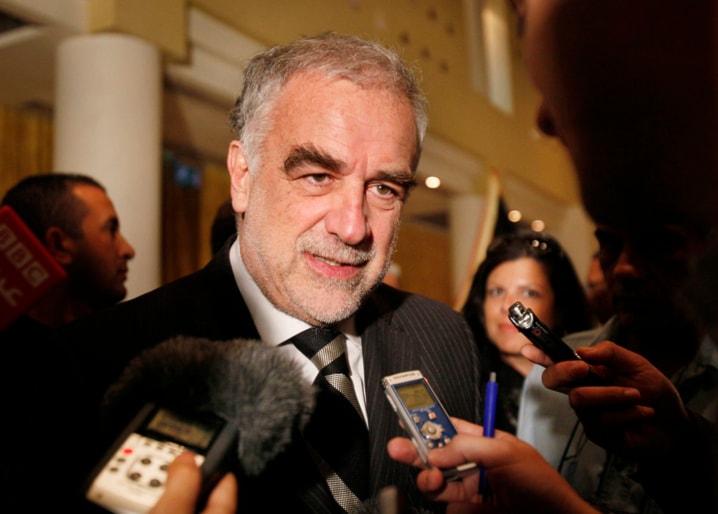TRIPOLI, Libya — A leading international prosecutor viewed human bones and charred clothing at the alleged site of a massacre that survivors say was committed by Gadhafi loyalists as Libya’s capital fell to advancing rebels.
Luis Moreno-Ocampo, prosecutor for the International Criminal Court, then pledged to help bring clarity to such unsolved crimes remaining from Libya’s civil war.
Earlier he announced that the court, based in The Hague, Netherlands, will not challenge Libya’s right to try Moammar Gadhafi’s son and one-time heir apparent in his own country and with Libyan judges. That cleared the way for Seif al-Islam, the only Gadhafi family member in Libyan custody, to answer for the alleged crimes of his late father’s four-decade rule over the oil-rich North African nation.
In The Hague, the ICC issued a statement saying the judges, not the prosecutor, must decide whether Libya can conduct the trial.
Moreno-Ocampo made the visit to the gruesome site, where a putrid stench rises from the ground, to determine whether to have the Netherlands-based court investigate it as part of its broader inquiry into alleged crimes committed by Gadhafi’s regime during the war.
The human bones and charred clothing cover the ground of a shed-like building on a site where Gadhafi’s now-deposed military had a base on the southwest outskirts of Tripoli.
Moreno-Ocampo spoke briefly with a man who believes his 18-year-old was killed in the alleged massacre, shook his hand and told him he understood his need for the truth.
“I hope we can help you to be sure, and then you can do a proper burial,” Moreno-Ocampo told the father, Ibrahim al-Shwedi, who is hoping DNA testing will give him that truth.
“This man needs clarity,” Moreno-Ocampo added.
The Libyan Society of the Missing says that 106 prisoners were killed in the building on August 23 when Gadhafi loyalists threw grenades inside.
Al-Shwedi said his son fought with the rebels in Misrata but had put down arms at the time of his August 21 capture. He said the youth, Ali Ibrahim al-Shwedi, was arrested for carrying a rebel flag.
One survivor, 50-year-old Abdullah Salim al-Dweeb, shared his story with the prosecutor.
“We were mistreated and badly tortured with electric shock, and we got beaten with different materials. We were burned by fire,” he said. He was among about 20 people who were released before the alleged killings.
After the visit, a spokesman for the court, Islam Shalabi, said Moreno-Ocampo believed “the site merits investigation.”
The ICC has charged Seif al-Islam and ex-intelligence chief Abdullah al-Senoussi with crimes against humanity for unleashing the brutal crackdown on an uprising that began in February and spiraled into a civil war.
Moammar Gadhafi also was charged, but the case has been terminated following his death in late October.
Moreno-Ocampo told reporters that Libya will help establish the judicial framework for the trial, which is widely seen as a test of the new Libyan government’s ability to uphold the rule of law. The country is struggling to build a judicial system and other governmental institutions practically from scratch after nearly 42 years of erratic one-man rule.
International rights groups have called on Libya to hand both men to the ICC for trial at The Hague, but Libya’s new leaders insisted he face justice at home.
“Libya is now established, it is a new government and they have the right to prosecute Seif and al-Senoussi here, and in accordance with our rules, the primacy is with the national system. If they conduct the proceedings, the court will not intervene,” Moreno-Ocampo said.
“I’m not competing for the case,” he added.
Seif al-Islam was captured Saturday by fighters from Zintan who tracked him to the southern desert. He was flown back to Zintan, 85 miles (150 kilometres) southwest of Tripoli, shown in pictures with a bandaged hand that he later said was injured in a NATO airstrike.
The International Committee of the Red Cross visited Seif al-Islam there on Tuesday and said he appeared to be in good health. Steven Anderson, a spokesman for the Geneva-based body, said the visit “took place in accordance with the ICRC’s customary working procedures” and all further findings would remain confidential.
An ICRC spokesman, Steven Anderson, said Wednesday that Seif al-Islam’s injuries had been “taken care of” and the detainee had been seen by a Libyan doctor. Anderson was unable to say how the injury was sustained.
Officials with the governing National Transitional Council also had reported that al-Senoussi, who also is wanted by France over the 1989 bombing of French airliner, was captured over the weekend in the southern city of Sabha and was being held in a secret location.
However, more senior Libyan officials have cast doubt on the claim. Libyan Justice Minister Mohammed al-Alagi said Wednesday that he couldn’t confirm that al-Senoussi was in custody.
Moreno-Ocampo said he didn’t know where al-Senoussi is.
